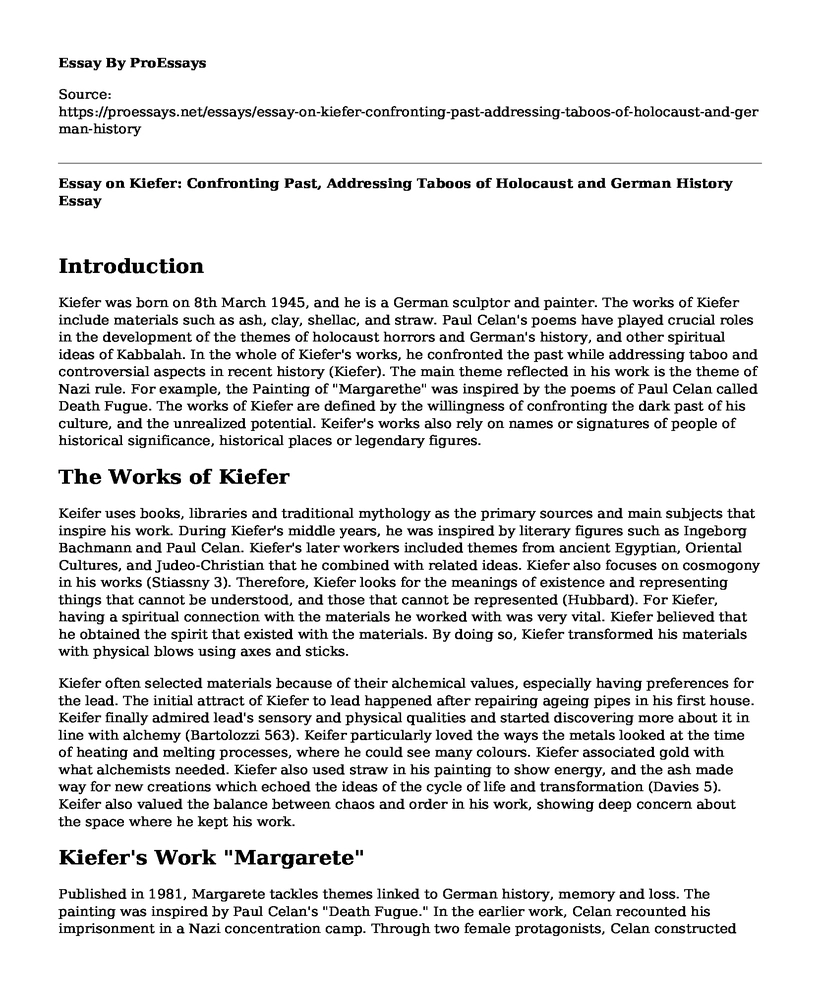Introduction
Kiefer was born on 8th March 1945, and he is a German sculptor and painter. The works of Kiefer include materials such as ash, clay, shellac, and straw. Paul Celan's poems have played crucial roles in the development of the themes of holocaust horrors and German's history, and other spiritual ideas of Kabbalah. In the whole of Kiefer's works, he confronted the past while addressing taboo and controversial aspects in recent history (Kiefer). The main theme reflected in his work is the theme of Nazi rule. For example, the Painting of "Margarethe" was inspired by the poems of Paul Celan called Death Fugue. The works of Kiefer are defined by the willingness of confronting the dark past of his culture, and the unrealized potential. Keifer's works also rely on names or signatures of people of historical significance, historical places or legendary figures.
The Works of Kiefer
Keifer uses books, libraries and traditional mythology as the primary sources and main subjects that inspire his work. During Kiefer's middle years, he was inspired by literary figures such as Ingeborg Bachmann and Paul Celan. Kiefer's later workers included themes from ancient Egyptian, Oriental Cultures, and Judeo-Christian that he combined with related ideas. Kiefer also focuses on cosmogony in his works (Stiassny 3). Therefore, Kiefer looks for the meanings of existence and representing things that cannot be understood, and those that cannot be represented (Hubbard). For Kiefer, having a spiritual connection with the materials he worked with was very vital. Kiefer believed that he obtained the spirit that existed with the materials. By doing so, Kiefer transformed his materials with physical blows using axes and sticks.
Kiefer often selected materials because of their alchemical values, especially having preferences for the lead. The initial attract of Kiefer to lead happened after repairing ageing pipes in his first house. Keifer finally admired lead's sensory and physical qualities and started discovering more about it in line with alchemy (Bartolozzi 563). Keifer particularly loved the ways the metals looked at the time of heating and melting processes, where he could see many colours. Kiefer associated gold with what alchemists needed. Kiefer also used straw in his painting to show energy, and the ash made way for new creations which echoed the ideas of the cycle of life and transformation (Davies 5). Keifer also valued the balance between chaos and order in his work, showing deep concern about the space where he kept his work.
Kiefer's Work "Margarete"
Published in 1981, Margarete tackles themes linked to German history, memory and loss. The painting was inspired by Paul Celan's "Death Fugue." In the earlier work, Celan recounted his imprisonment in a Nazi concentration camp. Through two female protagonists, Celan constructed powerful accounts about the holocaust, where the two women had intertwined fates. Kiefer used the aspects of Celan into visual arts towards encouraging viewers in reflecting the Holocaust's tragedy (Pimentel 15). Kiefer used the star as symbolic references to the lifecycles, the love of Germans for their land, and racial purity.
Interview
Upon interviewing Kiefer, he revealed that his works were inspired by the events in Nazi Germany and the Holocaust that marked massive killings of Jewish descent as purification of the land. Keifer stated, "I value the balance between chaos and order in my work, and everything I write about is inspired by previous work from renowned historians and artists" (Kiefer, 27th November 2019).
Works Cited
Bartolozzi, Giovanni, et al. "Anselm Kiefer: a study of his artistic materials." Archaeological and Anthropological Sciences 8.3 (2016): 563-574. Retrieved from https://www.researchgate.net/profile/Silvia_Centeno/publication/279951626_Anselm_Kiefer_a_study_of_his_artistic_materials/links/5ba67de592851ca9ed1f2693/Anselm-Kiefer-a-study-of-his-artistic-materials.pdf
Davies, Peter. "Genocide, Landscape, Beauty, Taboo: Reading Anselm Kiefer's Der Morgenthau-Plan with Walther von der Vogelweide's Lindenlied." Modern Languages Open (2017). Retrieved from https://www.modernlanguagesopen.org/articles/10.3828/mlo.v0i0.151/print/
Hubbard, Sue. "Margarete (1981) by Anselm Kiefer (Saatchi Collection)." The Independent, 23 Oct. 2011. Retrieved from https://www.independent.co.uk/arts-entertainment/art/great-works/margarete-1981-by-anselm-kiefer-saatchi-collection-970630.html
Kiefer, Anselm. "Anselm Kiefer Artworks & Famous Art." The Art Story, 2019. Retrieved from https://www.theartstory.org/artist/kiefer-anselm/artworks/
Pimentel, Dror. "Margarete and Her Spectre." Journal of Aesthetics and Phenomenology 4.1 (2017): 15-29. Retrieved from https://www.researchgate.net/profile/Dror_Pimentel/publication/317410232_Margarete_and_Her_Spectre/links/5c3cbe96299bf12be3c781ca/Margarete-and-Her-Spectre.pdf
Stiassny, Noga. "Anselm Kiefer/Ingeborg Bachmann: Visual Translation of Poetic Figuration." Jerusalem: Center for German Studies (2015). Retrieved from https://ef.huji.ac.il/sites/default/files/europe/files/noga_stiassny_for_web.pdf
Cite this page
Essay on Kiefer: Confronting Past, Addressing Taboos of Holocaust and German History. (2023, Mar 02). Retrieved from https://proessays.net/essays/essay-on-kiefer-confronting-past-addressing-taboos-of-holocaust-and-german-history
If you are the original author of this essay and no longer wish to have it published on the ProEssays website, please click below to request its removal:
- Essay Sample on Ancient Art of Greece and Rome
- Essay Sample on Cold War: Leadership of President Dwight Eisenhower
- Paper Example on 70s: Rapid Change in Society: A Look at 4 Articles
- Research Paper on Holocaust: Systematic Murder, Persecution & Loss of Liberty
- Theatre: Ancient Art Form Since Ancient Greece - Essay Sample
- Essay on US Govt's WWII Decision to Draft Japanese-Americans: Justified?
- Cervantes' El Celoso Extremeno: Wealthy Man's Unexpected Opportunity - Essay Sample







